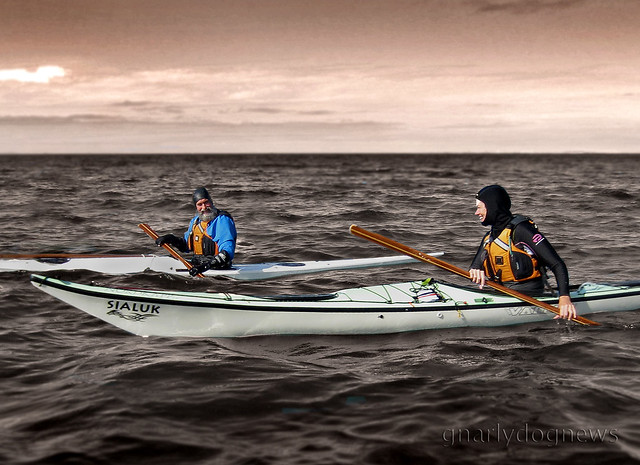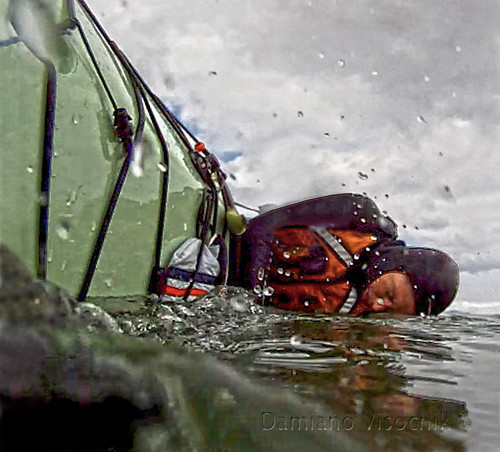Luckily I paddle in Queensland where winter means seas of minimum of 18C degrees :-)
Typically I can expect a short season where simple long sleeve Lycra rashguard is just not enough.
Winter usually has clear skies but windy conditions.
Our paddling group enjoys outings year round and we like to get wet, no matter what the weather is doing.

Reed tuilik (left) and Lavacore top and hood (right)
Rolling is slightly more refreshing than other times of the year but the effects of the wind on the wet body can be very cooling. Keeping the body warm just enough to prevent overheating (when underway paddling at a brisk pace) is usually not enough for the after effects of immersion.
Wet hair cools our bodies down very quickly.
Regulating the level of warmth needed for immersion and avoid overheating (when just touring) has always been a difficult balance. I would be freezing after rolling when the wind was blowing.
Stopping on the water to remove the PFD and add a layer is not that easy and sometimes dangerous.
Then Greg introduced me to wearing a hood.
Suddenly I was able to fine tune my body temperature. I would slip the hood on before starting to roll and remove it after my body warmed back up again. There is nothing more efficient and easier than resorting to a hood when the temperatures are variable.
The human head acts as a radiator for our body. There is a lot of blood supply to our brain and very little fat to insulate it. The hair on our skull protects some of the heat loss (if you have hair) but becomes rather useless when wet. The cooling effect of water evaporating is phenomenal as we all know how it feel to wear a wet T-shirt in a breeze...
To protect our heads from heat loss is probably the single most efficient way to keep warm.

Keeping warm with a hood
Most hoods are designed for underwater use where a thin layer of water is trapped between the skin and the neoprene. The water does not flush away and is warmed by our body heat thus creating an insulating layer. Neoprene is a fantastic insulator underwater but I find it not the best material for prolonged use above water. Neoprene does not breath and leaves the skin all clammy. Hearing is impaired and often an annoying drumming is heard from the neoprene over the ears.
For non immersion weather protection a hood from Reed Aquatherm seems to be adequate for Queensland winters. What I really wanted was the warming properties of neoprene but the comfortable breathability of Aquatherm.
Recently I found a product made from polyester that gives the insulation of 3 mm neoprene but still feels fantastic on the skin.
The inner surface has the face of short fleece (polyester) laminated to a windproof barrier that lets body perspiration through, mated to an outer surface that is highly water repellent.
The Lavacore hood keeps my head warm when rolling but dries fast when I start cruising again protecting me from the wind. After a short while my exercising body produces enough heat and I remove my hood without even having to slow down.
I believe that a hood is probably the most effective piece of clothing that a kayaker can have on board for an emergency. It can make the difference between shivering and feeling snug.
.



You should come to Tassie Gnarly. I paddled on the Derwent near my home yesterday and the water temperature was a cosy 4.7 degrees.
ReplyDeleteWe were doing rescue training last week a little further down the river where it is much warmer, 8.5 degrees. I used neoprene gloves, neoprene hood and drysuit and felt toasty warm in the water :-)
Gnarly,
ReplyDeleteMy PFD contents always include a hood in one of the pockets. Best piece of gear to have.
Paul
Geoff, are you nuts? :-)
ReplyDeleteGive me one good reason to come to Tassie in winter?
While not native, I am a Queenslander after all.
I run for cover when water temps dip below 16C...
Dead set, I actually bought a Lavacore hood today at the Sydney International Boat Show! Incredible timing!!
ReplyDeleteYou're spot on about the utility of using a garment that protects the head and neck. That holds true both on and off the water. The primary disadvantage of wearing a standard 3mm diver's hood is that the bottom of the hood tends to pop up, making a "cone of shame" similar to the one used by vets on pets. Fellow paddlers are still chuckling about the time I unknowingly wore one for hours in the cone position...
ReplyDeleteMoulton Avery
If "shame" is a concern when sea kayaking then we are in the wrong sport :-)
ReplyDeleteHas anybody ever pointed out to us that we (guys) are wearing skirts? and clad in that black rubber we look like a hard-core scene of bondage?
If only I took up golf instead...